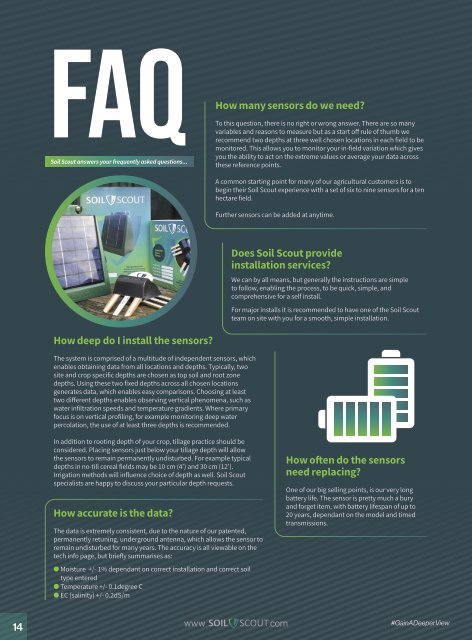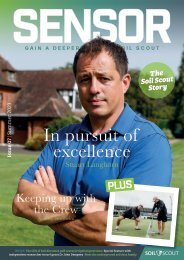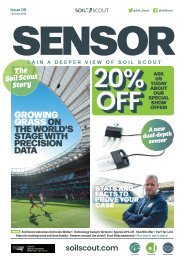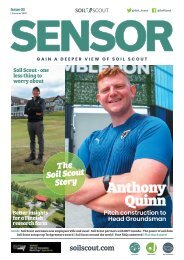You also want an ePaper? Increase the reach of your titles
YUMPU automatically turns print PDFs into web optimized ePapers that Google loves.
FAQ<br />
How<br />
<strong>Soil</strong> <strong>Scout</strong> answers your frequently asked questions...<br />
many sensors do we need?<br />
To this question, there is no right or wrong answer. There are so many<br />
variables and reasons to measure but as a start off rule of thumb we<br />
recommend two depths at three well chosen locations in each field to be<br />
monitored. This allows you to monitor your in-field variation which gives<br />
you the ability to act on the extreme values or average your data across<br />
these reference points.<br />
A common starting point for many of our agricultural customers is to<br />
begin their <strong>Soil</strong> <strong>Scout</strong> experience with a set of six to nine sensors for a ten<br />
hectare field.<br />
Further sensors can be added at anytime.<br />
Does <strong>Soil</strong> <strong>Scout</strong> provide<br />
installation services?<br />
We can by all means, but generally the instructions are simple<br />
to follow, enabling the process, to be quick, simple, and<br />
comprehensive for a self install.<br />
For major installs it is recommended to have one of the <strong>Soil</strong> <strong>Scout</strong><br />
team on site with you for a smooth, simple installation.<br />
How deep do I install the sensors?<br />
The system is comprised of a multitude of independent sensors, which<br />
enables obtaining data from all locations and depths. Typically, two<br />
site and crop specific depths are chosen as top soil and root zone<br />
depths. Using these two fixed depths across all chosen locations<br />
generates data, which enables easy comparisons. Choosing at least<br />
two different depths enables observing vertical phenomena, such as<br />
water infiltration speeds and temperature gradients. Where primary<br />
focus is on vertical profiling, for example monitoring deep water<br />
percolation, the use of at least three depths is recommended.<br />
In addition to rooting depth of your crop, tillage practice should be<br />
considered. Placing sensors just below your tillage depth will allow<br />
the sensors to remain permanently undisturbed. For example typical<br />
depths in no-till cereal fields may be 10 cm (4’) and 30 cm (12’).<br />
Irrigation methods will influence choice of depth as well. <strong>Soil</strong> <strong>Scout</strong><br />
specialists are happy to discuss your particular depth requests.<br />
How accurate is the data?<br />
The data is extremely consistent, due to the nature of our patented,<br />
permanently retuning, underground antenna, which allows the sensor to<br />
remain undisturbed for many years. The accuracy is all viewable on the<br />
tech info page, but briefly summarises as:<br />
l Moisture +/- 1% dependant on correct installation and correct soil<br />
type entered<br />
l Temperature +/- 0.1degree C<br />
l EC (salinity) +/- 0.2dS/m<br />
How often do the sensors<br />
need replacing?<br />
One of our big selling points, is our very long<br />
battery life. The sensor is pretty much a bury<br />
and forget item, with battery lifespan of up to<br />
20 years, dependant on the model and timed<br />
transmissions.<br />
14 www. .com<br />
#GainADeeperView


















